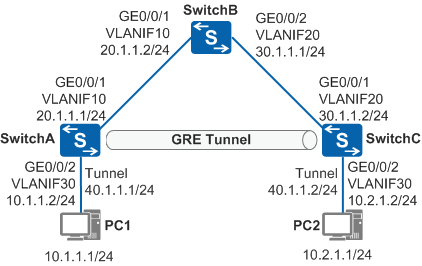Example for Configuring a Static Route for GRE to Implement Interworking Between IPv4 Networks
Networking Requirements
- SwitchA, SwitchB, and SwitchC communicate with each other through a public network. (The OSPF protocol is used in this example.)
- PC1 and PC2 run the IPv4 proprietary protocol and communicate with each other over the public network.
PC1 uses SwitchA and PC2 uses SwitchC as a default gateway.
Configuration Roadmap
To allow PC1 to communicate with PC2, you can configure a direct link between SwitchA and SwitchC. This allows you to set up a GRE tunnel and configure a static route to forward packets through tunnel interfaces to the peer.
The configuration roadmap is as follows:
Run OSPF on the devices to implement interworking among them.
Create tunnel interfaces on SwitchA and SwitchC to set up a GRE tunnel, and configure a static route passing through tunnel interfaces on SwitchA and SwitchC, so that traffic between PC1 and PC2 can be transmitted over the GRE tunnel.
Procedure
- Configure an IP address for each physical interface.
# Configure SwitchA.
<HUAWEI> system-view [HUAWEI] sysname SwitchA [SwitchA] vlan batch 10 30 [SwitchA] interface gigabitethernet 0/0/1 [SwitchA-GigabitEthernet0/0/1] port link-type trunk [SwitchA-GigabitEthernet0/0/1] port trunk allow-pass vlan 10 [SwitchA-GigabitEthernet0/0/1] quit [SwitchA] interface gigabitethernet 0/0/2 [SwitchA-GigabitEthernet0/0/2] port link-type access [SwitchA-GigabitEthernet0/0/2] port default vlan 30 [SwitchA-GigabitEthernet0/0/2] quit [SwitchA] interface vlanif 10 [SwitchA-Vlanif10] ip address 20.1.1.1 24 [SwitchA-Vlanif10] quit [SwitchA] interface vlanif 30 [SwitchA-Vlanif30] ip address 10.1.1.2 24 [SwitchA-Vlanif30] quit
# Configure SwitchB.
<HUAWEI> system-view [HUAWEI] sysname SwitchB [SwitchB] vlan batch 10 20 [SwitchB] interface gigabitethernet 0/0/1 [SwitchB-GigabitEthernet0/0/1] port link-type trunk [SwitchB-GigabitEthernet0/0/1] port trunk allow-pass vlan 10 [SwitchB-GigabitEthernet0/0/1] quit [SwitchB] interface gigabitethernet 0/0/2 [SwitchB-GigabitEthernet0/0/2] port link-type trunk [SwitchB-GigabitEthernet0/0/2] port trunk allow-pass vlan 20 [SwitchB-GigabitEthernet0/0/2] quit [SwitchB] interface vlanif 10 [SwitchB-Vlanif10] ip address 20.1.1.2 24 [SwitchB-Vlanif10] quit [SwitchB] interface vlanif 20 [SwitchB-Vlanif20] ip address 30.1.1.1 24 [SwitchB-Vlanif20] quit
# Configure SwitchC.
<HUAWEI> system-view [HUAWEI] sysname SwitchC [SwitchC] vlan batch 20 30 [SwitchC] interface gigabitethernet 0/0/1 [SwitchC-GigabitEthernet0/0/1] port link-type trunk [SwitchC-GigabitEthernet0/0/1] port trunk allow-pass vlan 20 [SwitchC-GigabitEthernet0/0/1] quit [SwitchC] interface gigabitethernet 0/0/2 [SwitchC-GigabitEthernet0/0/2] port link-type access [SwitchC-GigabitEthernet0/0/2] port default vlan 30 [SwitchC-GigabitEthernet0/0/2] quit [SwitchC] interface vlanif 20 [SwitchC-Vlanif20] ip address 30.1.1.2 24 [SwitchC-Vlanif20] quit [SwitchC] interface vlanif 30 [SwitchC-Vlanif30] ip address 10.2.1.2 24 [SwitchC-Vlanif30] quit
- Configure OSPF on the devices.
# Configure SwitchA.
[SwitchA] ospf 1 [SwitchA-ospf-1] area 0 [SwitchA-ospf-1-area-0.0.0.0] network 20.1.1.0 0.0.0.255 [SwitchA-ospf-1-area-0.0.0.0] quit [SwitchA-ospf-1] quit
# Configure SwitchB.
[SwitchB] ospf 1 [SwitchB-ospf-1] area 0 [SwitchB-ospf-1-area-0.0.0.0] network 20.1.1.0 0.0.0.255 [SwitchB-ospf-1-area-0.0.0.0] network 30.1.1.0 0.0.0.255 [SwitchB-ospf-1-area-0.0.0.0] quit [SwitchB-ospf-1] quit
# Configure SwitchC.
[SwitchC] ospf 1 [SwitchC-ospf-1] area 0 [SwitchC-ospf-1-area-0.0.0.0] network 30.1.1.0 0.0.0.255 [SwitchC-ospf-1-area-0.0.0.0] quit [SwitchC-ospf-1] quit
# After the configuration is complete, run the display ip routing-table command on SwitchA and SwitchC. The command output shows that they have learned the OSPF route destined for the network segment of the peer.
- Configure a tunnel interface.
# Configure SwitchA.
[SwitchA] interface tunnel 1 [SwitchA-Tunnel1] tunnel-protocol gre [SwitchA-Tunnel1] ip address 40.1.1.1 255.255.255.0 [SwitchA-Tunnel1] source 20.1.1.1 [SwitchA-Tunnel1] destination 30.1.1.2 [SwitchA-Tunnel1] quit
# Configure SwitchC.
[SwitchC] interface tunnel 1 [SwitchC-Tunnel1] tunnel-protocol gre [SwitchC-Tunnel1] ip address 40.1.1.2 255.255.255.0 [SwitchC-Tunnel1] source 30.1.1.2 [SwitchC-Tunnel1] destination 20.1.1.1 [SwitchC-Tunnel1] quit
# After the configuration is complete, the tunnel interfaces turn Up and can ping each other. This indicates that a direct tunnel has been set up.
# The command output on SwitchA is used as an example.
[SwitchA] ping -a 40.1.1.1 40.1.1.2 PING 40.1.1.2: 56 data bytes, press CTRL_C to break Reply from 40.1.1.2: bytes=56 Sequence=1 ttl=255 time=1 ms Reply from 40.1.1.2: bytes=56 Sequence=2 ttl=255 time=1 ms Reply from 40.1.1.2: bytes=56 Sequence=3 ttl=255 time=1 ms Reply from 40.1.1.2: bytes=56 Sequence=4 ttl=255 time=1 ms Reply from 40.1.1.2: bytes=56 Sequence=5 ttl=255 time=1 ms --- 40.1.1.2 ping statistics --- 5 packet(s) transmitted 5 packet(s) received 0.00% packet loss round-trip min/avg/max = 1/1/1 ms - Configure a static route.
# Configure SwitchA.
[SwitchA] ip route-static 10.2.1.0 255.255.255.0 tunnel 1
# Configure SwitchC.
[SwitchC] ip route-static 10.1.1.0 255.255.255.0 tunnel 1
# After the configuration is complete, run the display ip routing-table command on SwitchA and SwitchC. The command output shows the static route from the tunnel interface to the user-side network segment.
# The command output on SwitchA is used as an example.
[SwitchA] display ip routing-table 10.2.1.0 Route Flags: R - relay, D - download to fib, T - to vpn-instance ------------------------------------------------------------------------------ Routing Table : Public Summary Count : 1 Destination/Mask Proto Pre Cost Flags NextHop Interface 10.2.1.0/24 Static 60 0 D 40.1.1.1 Tunnel1
PC1 and PC2 can ping each other.
Configuration Files
SwitchA configuration file
# sysname SwitchA # vlan batch 10 30 # interface Vlanif10 ip address 20.1.1.1 255.255.255.0 # interface Vlanif30 ip address 10.1.1.2 255.255.255.0 # interface GigabitEthernet0/0/1 port link-type trunk port trunk allow-pass vlan 10 # interface GigabitEthernet0/0/2 port link-type access port default vlan 30 # interface Tunnel1 ip address 40.1.1.1 255.255.255.0 tunnel-protocol gre source 20.1.1.1 destination 30.1.1.2 # ospf 1 area 0.0.0.0 network 20.1.1.0 0.0.0.255 # ip route-static 10.2.1.0 255.255.255.0 Tunnel1 # return
SwitchB configuration file
# sysname SwitchB # vlan batch 10 20 # interface Vlanif10 ip address 20.1.1.2 255.255.255.0 # interface Vlanif20 ip address 30.1.1.1 255.255.255.0 # interface GigabitEthernet0/0/1 port link-type trunk port trunk allow-pass vlan 10 # interface GigabitEthernet0/0/2 port link-type trunk port trunk allow-pass vlan 20 # ospf 1 area 0.0.0.0 network 20.1.1.0 0.0.0.255 network 30.1.1.0 0.0.0.255 # return
SwitchC configuration file
# sysname SwitchC # vlan batch 20 30 # interface Vlanif20 ip address 30.1.1.2 255.255.255.0 # interface Vlanif30 ip address 10.2.1.2 255.255.255.0 # interface GigabitEthernet0/0/1 port link-type trunk port trunk allow-pass vlan 20 # interface GigabitEthernet0/0/2 port link-type access port default vlan 30 # interface Tunnel1 ip address 40.1.1.2 255.255.255.0 tunnel-protocol gre source 30.1.1.2 destination 20.1.1.1 # ospf 1 area 0.0.0.0 network 30.1.1.0 0.0.0.255 # ip route-static 10.1.1.0 255.255.255.0 Tunnel1 # return
